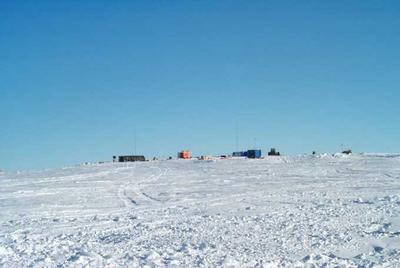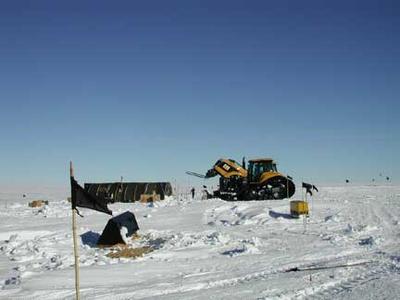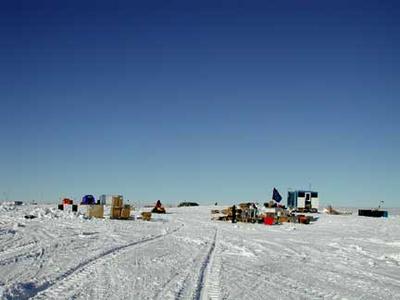21 November, 2002
Date: 11/21/02
Time of Log: 9 PM local time
Latitude: 120 degrees West
Longitude: 80 degrees South
Temperature: -20 C / -4 F
Wind speed: 6 knots
Wind Chill: -28 C / -18 F
Wind direction: Northeast
Meters of ice collected: 0
The day started out with a superb breakfast made by Andrea in the Byrd
Jamesway shelter: fresh eggs, kiwi fruit, freshly made bread…
Jamesways are military green on the outside and a lighter green inside.
They are made of wooden hoops attached to a wooden floor, with canvas
covered blankets for walls and ceiling. This parcticular Jamesway has
eight sections, making it 16 by 32 feet. That makes it somewhat
crowded with all seventeen of us (including Mark Buckley the filmmaker
and Kirk Salverson, who will be heading back to McMurdo shortly after
we leave for the Pole). We’d better get used to it though soon we
will have to combine kitchen with living quarters: the three women
(Susan, Betsy, and Andrea) will sleep in the wooden shelter that is
also the kitchen. Seven of the men (Markus, Eric, Gordon, Blue, Steve,
Dan, and Jim) will sleep in the “Blue Room”, a 20 by 8 foot shelter
that doubles as a laboratory for Markus and Betsy’s atmospheric
chemistry work, as well as for weather observations and radio
communication. Paul, Lynn, Karl and Mark will all be in a blue
weatherhaven a modern version of the Jamesway, with nylon rather than
canvas walls.
The weather this morning was beautiful; warm (minus 12 C), calm and
sunny. We continued getting all our gear together and began to
position vehicles and sleds so that we can hook them up to the
Challengers. Lots of little things to do: mount the GPS antenna to the
roof of the blue room, find the cables connecting the laptop to the
weather station, sort out the food. Eric spent a couple of hours
sorting through crevasse rescue gear. This is something we doubt very
much we will need, but which we will need very badly in the unlikely
event that one of our vehicles or, worse, one of us, falls into a
crevasse. It is unlikely because we are traveling through areas where
the ice is moving quite slowly, and is not likely that there will be
any big cracks (crevasses); these tend to occur in fast-moving areas or
where the ice is going around sharp corners or over steep cliffs. It
is also unlikely because we will be constantly monitoring our crevasse
detector: this sends radio signals into the ice that, if they hit a
crevasse will bounce back and produce an obvious signal on our computer
screen. If one of the Challengers were to fall in, we could not
possibly get it out, but we could, and would, use our ropes to lower
ourselves down to the driver and get them back to the surface.
Paul, Mark, Susan, and Dan spent part of the day getting the 2” ice
coring drill set up. This drill, which Mark designed and built, worked
well last year but will be even better this year we expect. Mark has
put together a fancy new winch system that makes raising and lowering
the drill much easier.
Later in the day, the weather became a few degrees colder and the wind
picked up. It doesn’t really become unpleasant until it reaches 20
knots (nautical miles per hour) and snow starts blowing about. Still,
the 10 knots it reached today is enough to make it feel a lot colder,
especially on the face. We were all reminded that it will be very cold
this year as we head towards the Pole.

A view of Byrd Surface Camp.

Here you see one of our Challenger 55 "Cats" next to the Jamesway shelter. The black flags mark areas that are reserved for the vehicles "roads".

To the left is the polarhaven and behind that is the "Blue Room". If you look very closely, in the center is a person.

Here is another view of the camp with cargo stacked waiting to be loaded.

This is a better view of the "Blue Room". The tall thing on top is the wind vanes for the generator. We get most of our power for everyday living from the wind. We even recharge our batteries with wind power.
Contact the TEA in the field at
.
If you cannot connect through your browser, copy the
TEA's e-mail address in the "To:" line of
your favorite e-mail package.
|
